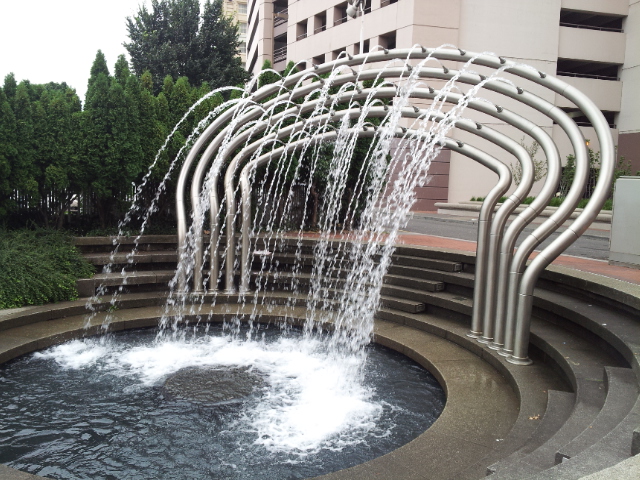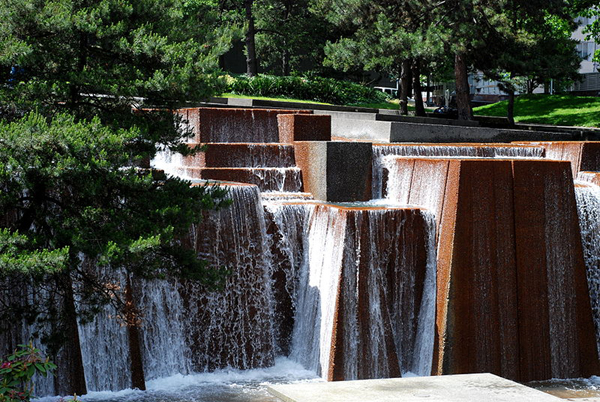Ore.
While I was editor at Pool & Spa News in 1990 or 9'91, I was invited to Portland, Ore., to make a presentation to a regional meeting of what was then the National Spa & Pool Institute about what I'd experienced in becoming a pool owner.
I had been with the magazine since 1987, and what had intrigued a northwestern friend of mine on NSPI's board was the fact that my family had moved houses in 1989 and had taken possession of a nice pool and spa in the process. (More important to me was the fact that we needed more space to accommodate our second daughter, who had arrived in October 1988.)
My speech was on a Friday afternoon, and those were the days when you had to stay over a Saturday to avoid getting shafted on the cost of airline tickets. In those bad old days, it was actually much cheaper to stay an extra night in Oregon with all of the associated expenses than it would've been to fly home Saturday.
This delayed return home, however, had the beneficial effect of allowing me to do a bit of local exploring. I'd been to Portland many times before, having lived down the Willamette River in Eugene for a few years early in the 1980s. But now that my focus was more on water than it had been previously, I visited several fountains and public waterfeatures and particularly enjoyed seeing some of Lawrence Halprin's work there for the first time.
But that wasn't what most captured my imagination that day: Instead, it was the more modest Skidmore Fountain. Located in Portland's Old Town Historic District, it dates back to 1888 and reminded me strongly of the sort of remarkable civic fountains I'd seen in cities all over Europe in my travels in the 1970s.
The Skidmore Fountain wasn't much to look at by 1990. It was clearly in need of repair and restoration, but it was just as clearly charming.
It was named after a wealthy pharmacist named Stephen Skidmore, who contributed to the construction through his will, and executed by Olin Levi Warner, an American sculptor who studied at the École nationale supérieure des Beaux-Arts in Paris before setting up a studio in New York City.
When I wrote about Lawrence Halprin's Keller Fountain in Portland, Ore., in August 2012, I had meant to cover its Portland cousin, the Lovejoy Fountain, within a few months that have now turned into several years. Apologies for failing to double back sooner, because they really do fit together better than this span of time would suggest.
Lovejoy Plaza was the first completed installation in what is now known as the Portland Open Space Sequence, which includes four separate urban environments linked by promenades in a span covering eight blocks. Physically, Lovejoy Plaza is the second of the four spaces in the chain, which starts with the Source Fountain, moves past the Lovejoy Fountain, rolls through Pettygrove Park and ends up at the Keller Fountain.
Halprin was a pioneering advocate for this sequenced, themed approach to arranging urban spaces, and the fact that he became involved in Portland at a time of 1960s-style urban redevelopment gave him the opportunity to exercise his philosophy on a grand scale - and, more important, with a relatively clean slate.
The Lovejoy Fountain is a beautiful example of Halprin's aquatic work - varied elevations, expressive materials, dramatic contours, vigorous flows, wonderful sound. He's a master of mood management, in this case surrounding the fountain's rougher edges with plants and trees that soften its visual features and make the plaza more inviting. He's also a master of the art of engagement, providing all sorts of ways for passersby to get up close to the water and interact with it on multiple levels (this despite the fact that there are signs warning against coming in contact with it).
In this case as with several of his other designs, the Lovejoy Fountain is also a brilliant performance space - no surprise given Halprin's frequent collaborations with his wife, Anna, an accomplished performer who certainly encouraged him to look at public spaces as stages for dancers, backdrops for musicians and places for playful movement around the water. (One of the videos linked below put the fountain's artistic flexibility on brilliant display.)
The four spaces were designed between 1963 and 1970, with Lovejoy Plaza completed first, in 1966. Satoru Nishita served as partner-in-charge for the project after becoming a principal at Lawrence Halprin + Associates in 1964.
I like everything about this fountain, from its approachability to its reflection of nature and its debt to terrain I know well from my own time spent exploring the Columbia River Valley and the Sierra Nevada and Cascade ranges. It's manifestly a composed, artificial space, but it operates on a level where, like a great abstract painting, it gives observers the chance to run free with their own interpretations and responses.
If you can't tell by now, I'm a big fan of Mr. Halprin's work. The next time you're in the Great Northwest, spend an afternoon in downtown Portland and I think you'll see why.
To see an odd 360-degree video of the Lovejoy Fountain, click here and be sure to use the effect. It takes a while to get down to business, but it's worth the wait.
To see a video in which Lovejoy Fountain host an interactive art project, click here.
In my various trips near and far, I ve occasionally experienced fountains that function only sporadically. if you'll recall, for example, i wrote in december 2012 about ricardo legorreta's purple aqueduct los angeles'pershing square, which, i've been told, runs when the local water table permits it which is why had to visit square three times before witnessed operation.
I've also seen fountains that were installed with either official names or no names at all - but that are universally referred to by locals with other, generally less-respectful names. I wrote in June 2013 about the Inverted Fountain on the UCLA campus, for instance, mentioning that irreverent students (at least of my generation) called it the Perpetual Toilet because of the familiar way the water circled so voluminously into its drain.
Now I offer up a fountain that scores big in both of these odd categories: It's an unnamed fountain in Portland, Ore., that has what is often complained of as an overly sensitive wind sensor that shuts the water off completely at what seems the slightest provocation. It also has the distinction of looking a bit like the sprayer bar in a commercial convenience, so most people call it the Car Wash Fountain.
Made up of rows of curving metal tubes, the fountain was installed in its compact Portland park in 1977 with a design from the firm of Carter, Hull, Nishita, McCulley and Baxter. (Nishita had been an associate of Lawrence Halprin's, but separation from the great man evidently led him on a different stylistic path.) The spray jets apparently make pedestrians miserable when the wind blows (which it often does in Portland), so when the breeze reaches a scant two miles an hour, the water stops flowing. This low threshold makes it a bit too easy to find the Car Wash closed for business.
I have to say that I'm not terribly fond of this fountain - and it's only partially the result of having had the misfortune of stopping by to see it on a cold, blustery day. Basically, I don't think it's an attractive contribution to the cityscape; I'd also like to think it was incumbent on the designers to recognize the problems even a gentle breeze in this particular location would cause with their fountain's basic operation.
That doesn't mean the fountain isn't worth a visit: People who write about Portland's attractions look at it with obvious pride - and it's not just because they like referring to it as the Car Wash Fountain. Maybe it's just me?
Then as now, I look on the bright side: The Car Wash Fountain is within easy walking distance of a bunch of other fine Portland fountains, and it's hard to stay upset when you have about a mile to walk to the Keller and Lovejoy fountains - two of Halprin's masterpieces.
For a very brief video showing the fountain in action, click here.
Few who shape the water will ever make as profound an aquatic mark on the world as did landscape architect Lawrence Halprin. He’s long been a favorite of mine, and we’ve called attention to his work and influence on more than a few occasions in the pages of WaterShapes and on WaterShapes.com. Along with Thomas Church and very few others, he defined the way we all
Back in a time before I had anything to do with watershaping, I lived for a few years in Eugene, Ore. – a smallish college town that always left me craving more-urban spaces. Portland was up the road by a couple hours, and in the days before our first child appeared, my wife and I would make fairly frequent trips to visit the closest real city we had available. We loved

















